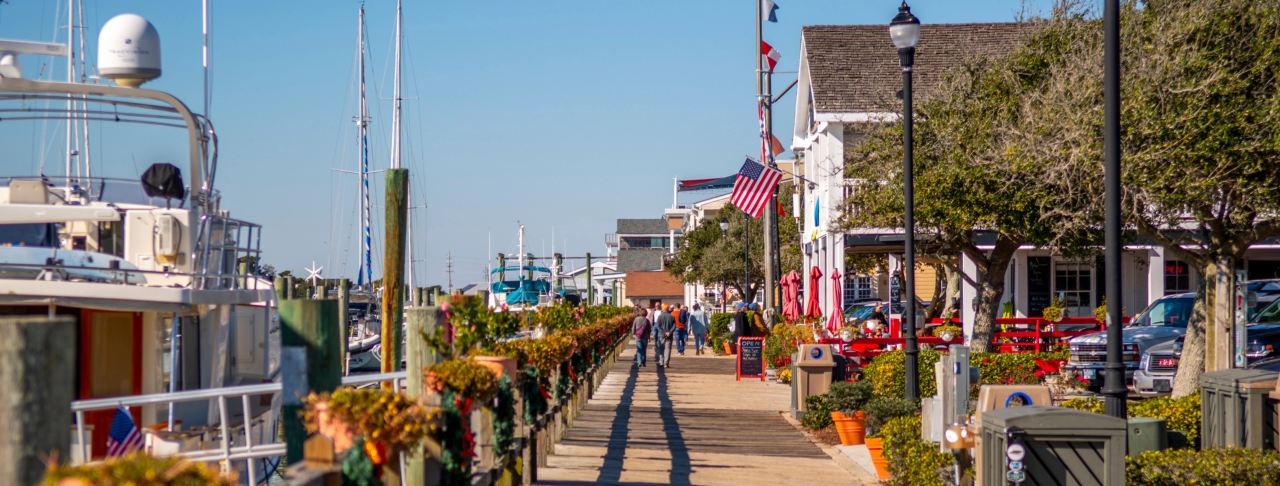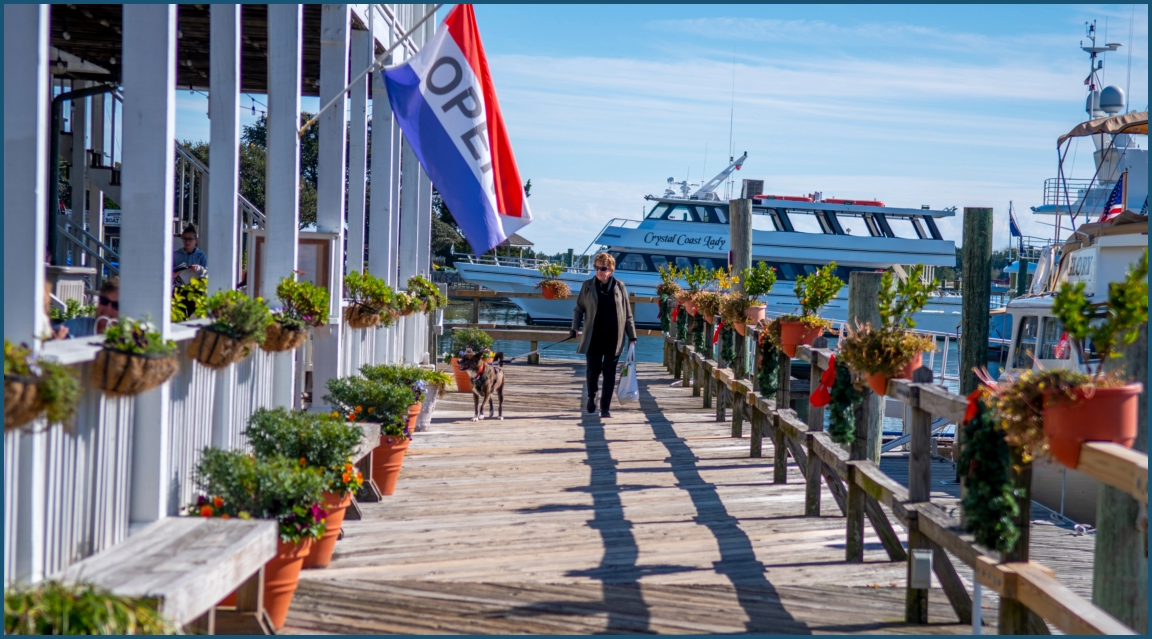
ALL ABOUT
BEAUFORT,
NORTH CAROLINA
A LITTLE ABOUT THE HISTORY
Beaufort, North Carolina is located south of the center of Carteret County. It is located on Beaufort Inlet, a channel leading south
to the Atlantic Ocean. To the west is the tidal Newport River, separating the town from Morehead City. To the east is the
unincorporated neighborhood of Lenoxville, extending to the North River, another tidal river. U.S. Route 70 passes through
Beaufort, leading west across the Newport River to Morehead City and northeast 31 miles to its end in the town of Atlantic.
According to the United States Census Bureau, Beaufort has a total area of 5.6 square miles, of which 4.6 square miles is land
and 1.0 square mile, or 17.75%, is water. Beaufort has a humid subtropical climate, which is characterized by long, hot summers,
and short, cool winters.
Established in 1713, Beaufort, N.C., is a charming coastal town nestled along the waters of Beaufort Inlet, a picturesque channel
that leads gracefully south to the vast expanse of the Atlantic Ocean. As the fourth oldest town in North Carolina and the proud
seat of Carteret County, Beaufort is home to approximately 4,464 residents (2020 census), yet its quaint streets come alive with a
bustling flow of visitors during the balmy, sunlit months.
Once called Fishtown, owing to a deep-rooted fishing heritage that has long defined the county’s history, Beaufort later took its
name in honor of Henry Somerset, Duke of Beaufort. Born as a humble fishing village and a safe harbor reaching back to the late
1600s, the town has attracted a mosaic of souls over the centuries—intrepid patriots, daring privateers, savvy merchants, and
ingenious craftsmen—all of whom left their mark through the construction of distinctive Bahamian and West Indian-style homes
and communal buildings. Today, nearly 150 lovingly restored historic homes proudly display plaques that commemorate the
names of the town’s earliest known residents and the dates of their original construction. One of Beaufort’s more infamous
resident’s was Edward Teach, more notably known as, Blackbeard. Blackbeard’s notorious pirate ship the Queen Anne’s Revenge
was dramatically unearthed in Beaufort Inlet in 1996 after lying silently beneath the waves for nearly three centuries.
Street names reflect the early development of the town: Ann Street for Queen Anne; Craven Street for the Earl of Craven; Turner
Street for Robert Turner, owner of the land that was surveyed for the town; Pollock Street for Gov. Thomas Pollock; and Orange
Street for William, Prince of Orange, who became William III of England.
In its early days, Beaufort’s economy thrived on the abundant natural offerings of its surroundings. The daily lives of its people
revolved around the rich bounty of the sea—fishing and whaling—as well as the production of lumber and naval stores,
shipbuilding, and farming. Despite boasting the safest and most navigable harbor of any North Carolina port, the town’s bustling
commercial activities never fully blossomed, largely due to its physical isolation from the interior lands. In modern times, however,
Beaufort has reinvented itself; tourism now forms the economic backbone, complemented by a regional boat-building industry,
while marine science research continues to play an influential role.
The meticulously planned layout of Beaufort Towne, established in 1713 (incorporated in 1723), still survives in a charming 12-
block area that has earned a revered spot on the National Register of Historic Places. Every corner of Beaufort seems to whisper
a story, with side streets adorned with countless tributes to local legends and history. The town boasts dozens of lovingly restored
historic homes, each marked by a plaque awarded by the Beaufort Historical Association, intermingled with inviting shops,
atmospheric restaurants, vibrant galleries, and other unique community treasures that tell the tale of its storied past.
The town is home to the Duke University Marine Laboratory (Nicholas School of the Environment), and the National Oceanic and
Atmospheric Administration (NOAA) Center for Coastal Fisheries and Habitat Research. It is also the location of the Rachel Carson
Reserve, part of the N.C. Coastal Reserve and National Estuarine Research Reserve system. No visit to Beaufort would be
complete without an hour or so exploring the North Carolina Maritime Museum, a beloved institution perched along Front Street.
Housed in an unassuming, cedar-shaked two-story building festooned with local flags, the museum stands as a highlight of the
downtown scene, offering an ever-changing panorama of exhibits that immerse visitors in a world of maritime splendor. It’s also
the official repository for the artifacts from the wreckage of Blackbeard’s flagship; a section dedicated to the famous pirate.
Named by Travel & Leisure as “America’s Favorite Town” among other accolades, Beaufort brings even more to the table than
meets the eye. Dock your boat at a downtown marina and walk from one charming boutique to the next. Take in some history at
the two-acre Beaufort Historic Site site on Turner Street featuring six authentically restored building. Beaufort is sometimes
confused with a city of the same name in South Carolina; the two are distinguished by different pronunciations.
"Relaxing," "fascinating," “historic,” and "nautical" are just some words that might well encapsulate downtown Beaufort. This
intimate section of the town, though modest in its nearly 3-square-mile expanse, magnetically draws the majority of its visitors.
With its scenic avenues lined with maritime shops, art galleries, and inviting restaurants, Downtown Beaufort is a vibrant tapestry
woven with the very best threads of the Inner Banks spirit.













